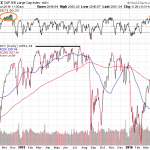Janet Yellen’s Congressional testimony today brought up an interesting line of questioning from Ted Cruz who said that the Fed was “passively tightening” policy in 2008 which contributed to the financial crisis. This is a popular line of reasoning among many economists. David Beckworth, whose work I admire greatly, posted some nice comments explaining this view. In essence, by not signaling an offsetting change in the expected path of monetary policy, the Fed was not loosening in 2008. They were actually allowing financial conditions to tighten.
This view runs counterintuitive to the conventional idea that monetary policy was loosened in 2008 as the Fed cut interest rates. I don’t disagree with David and other Market Monetarists who often espouse this view. But I do think they overstate the potential for the Fed to halt the crisis. In my view, the mountain of debt that built up during the housing bubble was akin to a snow pack that became increasingly unstable. It wasn’t a matter of if it would fall, but when it would fall. And while the Fed could have done more to be proactive I think it would have taken an incredible act of prescience to make a significant difference.
The financial crisis was a complex set of interconnected avalanches, but I think we can simplify things to better understand the cause, effect and potential preventions. The Boston Fed provided a nice summary of the cause of the crisis in a 2010 report titled “Asset Bubbles and Systemic Risk”¹:













Leave A Comment